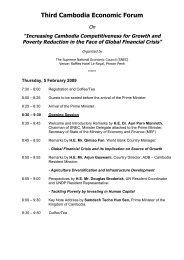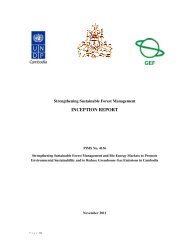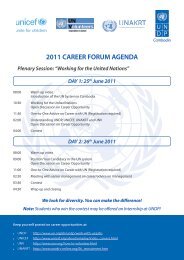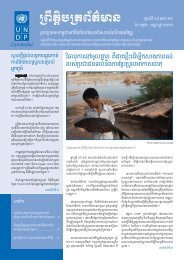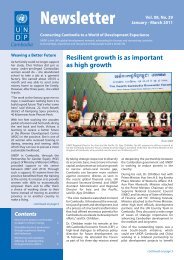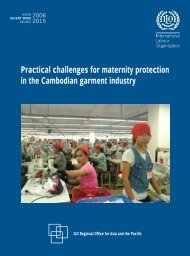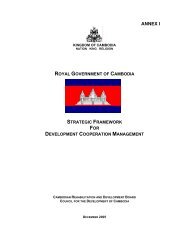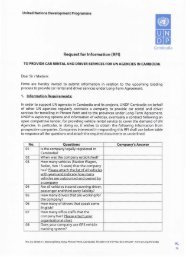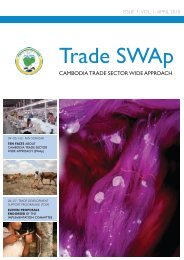UN Analysis Final.pdf - United Nations in Cambodia
UN Analysis Final.pdf - United Nations in Cambodia
UN Analysis Final.pdf - United Nations in Cambodia
Create successful ePaper yourself
Turn your PDF publications into a flip-book with our unique Google optimized e-Paper software.
Table 5-1. Labour market programmes (2005-2006)<br />
Programme<br />
Institution/<br />
Agency<br />
Beneficiaries<br />
(Number)<br />
Expenditure<br />
(Million US$)<br />
Vocational Tra<strong>in</strong><strong>in</strong>g (MoLVT) MoLVT 13,000 0.78<br />
Vocational tra<strong>in</strong><strong>in</strong>g for orphans and widowed and<br />
female-headed households<br />
MoWA 2,447 0.11<br />
Vocational tra<strong>in</strong><strong>in</strong>g (SESDP) MoLVT/ADB N/A 1.08<br />
Food for Asset (Food for Work) WFP 11,504 0.14<br />
Total 25,504 1.97<br />
Source: ADB 2006<br />
5.2 STATISTICAL PROFILE OF YOUTH AND EMPLOYMENT<br />
In recent years, youth population has <strong>in</strong>creased remarkably. The M<strong>in</strong>istry of Plann<strong>in</strong>g (MoP) (2006) <strong>in</strong>dicates<br />
that those aged 15–24 represented 26 per cent of the population <strong>in</strong> 2004, and that large numbers of them are<br />
enter<strong>in</strong>g the labour force as a result of a baby boom <strong>in</strong> the 1980s. A common issue among this group is ris<strong>in</strong>g<br />
unemployment. Because <strong>Cambodia</strong>’s poor and very poor youth cannot afford to be unemployed, they work<br />
for low pay, with little or no social or safety protection and on short-term or <strong>in</strong>formal contracts. The f<strong>in</strong>d<strong>in</strong>gs<br />
presented below suggest that measures must be taken to ensure that youth do not add to underemployment<br />
<strong>in</strong> the countryside or to higher rates of urban unemployment, but that they should contribute <strong>in</strong>stead to<br />
growth and development through productive employment.<br />
5.2.1 EMPLOYED YOUTH<br />
Youth labour force participation rate: <strong>Cambodia</strong>’s labour force participation rate is one the highest <strong>in</strong> the<br />
region. A large proportion of youths born <strong>in</strong> the 1980s began to reach work<strong>in</strong>g age <strong>in</strong> the mid-1990s. As large<br />
numbers of young people began enter<strong>in</strong>g the labour force, the economy came under enormous pressure to<br />
create new jobs. Tables 5.2 shows labour force participation by age and gender. Some 75 per cent of all those<br />
aged 10 and older were economically active <strong>in</strong> 2004.<br />
Table 5-2. Total and economically active population by age group- CSES 2003-04<br />
Age<br />
Group<br />
Total Men Women<br />
Total<br />
Population<br />
Active<br />
Population<br />
Activity<br />
Rate<br />
Total<br />
Population<br />
Active<br />
Population<br />
Activity<br />
Rate<br />
Total<br />
Population<br />
Active<br />
Population<br />
Activity<br />
Rate<br />
0- 14 1,817,863 874,591 48.1 924,885 454,441 49.1 892,978 420,150 47.1<br />
15-19 1,705,251 1,241,165 72.8 875,578 634,646 72.5 829,673 606,519 73.1<br />
20-24 1,443,322 1,206,606 83.6 717,496 624,888 87.1 725,826 581,718 80.1<br />
25-29 815,318 708,957 87.0 388,058 367,958 94.8 427,260 340,999 79.8<br />
Total 5,781,754 4,031,319 69.7% 2,906,017 2,081,933 71.6% 2,875,737 1,949,386 67.8%<br />
Source: CSES 2004<br />
Situation <strong>Analysis</strong> of Youth <strong>in</strong> <strong>Cambodia</strong><br />
55




